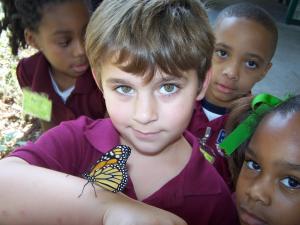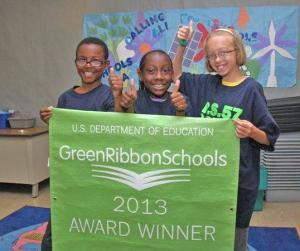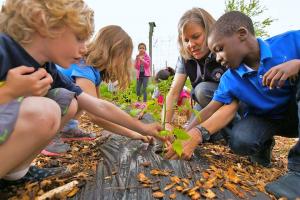Go Green This Spring, Apply for a Green Ribbon School Award by Jim Elder
By Kate Falk
Posted on 2020-02-20
Is your school a green school?
 Is it doing amazing work in reducing environmental impacts, such as waste, water, energy, and transportation?
Is it doing amazing work in reducing environmental impacts, such as waste, water, energy, and transportation?
Does your school work to improve the health and wellness of students and faculty with coordinated school health programs that take into consideration air quality, contaminant control, acoustics, daylighting, thermal comfort, school food, and more?
Is your school a leader in effective environmental and sustainability education that emphasizes hands-on, real-world learning, civic engagement, STEM connections, and green career preparation?
Then you should apply for a Green Ribbon School Award sponsored by the U.S. Department of Education and administered by state education authorities.
 Only 50-80 schools in the country win each year, so it’s a big deal. it puts your school in an elite national group of green schools; winning schools get a good deal of national, state and local press; the award helps schools attract more funding as well as community support; and the award builds school spirit both within the school and in the community. Winning schools are invited to the award ceremony in Washington DC.
Only 50-80 schools in the country win each year, so it’s a big deal. it puts your school in an elite national group of green schools; winning schools get a good deal of national, state and local press; the award helps schools attract more funding as well as community support; and the award builds school spirit both within the school and in the community. Winning schools are invited to the award ceremony in Washington DC.
The premise of the Green Ribbon Schools is simple: It seeks to promote effective school sustainability and collaboration. Applicants are measured on how they perform on three key pillars:
- Reducing environmental impact and costs;
- Improving health and wellness; and
- Providing effective environmental and sustainability education.
Here are two examples of the great programs coming out of Green Ribbon Schools:
For over twelve years, Virginia Beach Public Schools has been moving towards a more sustainable model. To date, it has completed eight LEED buildings ranging from basic certification to Platinum. The Sustainable Schools Committee works with a Sustainable School Liaison in each school, and have been able to establish 64 schools with outdoor teaching gardens, 72 schools with environmental clubs, and over 60 schools that partner with third party environmental organizations like the Chesapeake Bay Foundation.
with third party environmental organizations like the Chesapeake Bay Foundation.
Environmental education extends far beyond the walls of a traditional science classroom at Quincy High School, a career and technical school. Summer Leadership Camp, which pairs upperclassmen with incoming 9th grade students, offers an outdoor learning experience that builds friendship and leadership skills. The school’s STEM wing is home to a greenhouse, where students are actively involved in learning how to grow their own food. Students complete “Service to School and Community” hours that allow them to focus on how singular responsible actions can benefit the larger environment and affect the sustainable practices of other members within the community.
Schools and districts do not apply for the award to the U.S. Department of Education, but to their state education authorities. (State participation in the award is voluntary so contacting your state official will help them to determine their level of participation.)
If you are interested in learning more, I encourage you to contact your state departments of education or the state authority on this list.
Jim Elder is Executive Director of the Campaign for Environmental Literacy.
The mission of NSTA is to promote excellence and innovation in science teaching and learning for all.
Disclaimer: The views expressed in this blog post are those of the author(s) and do not necessarily reflect the official position of the National Science Teaching Association (NSTA).

